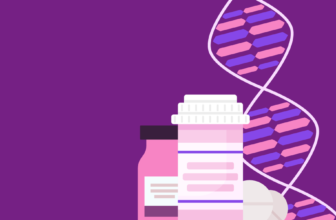
[adinserter block=”3″]
Early in her medical career, Nieca Goldberg, M.D., medical director of the Atria Institute in New York City, associate professor of medicine at NYU Grossman School of Medicine and member of HealthyWomen’s Women’s Health Advisory Council, realized that the healthcare field didn’t believe women could have heart problems. She decided to change that because so many women and their symptoms were ignored.
Goldeberg is also the author of the highly acclaimed book “Women Are Not Small Men,” which has since been updated and retitled “The Women’s Healthy Heart Program: Lifesaving Strategies for Preventing and Healing Heart Disease.”
Our interview follows, edited for clarity and length.
HealthyWomen: How did you become interested in women’s heart health?
Nieca Goldberg, M.D.: In the first few months of my being an attending physician, I was making rounds in the coronary care unit of my hospital. A woman I recognized as an employee at the hospital was a patient there and she mentioned she had been to a range of doctors who told her things like “you’re stressed out, take a vacation.” One gave her a prescription for Valium. She called one of my colleagues, and he suggested she go to an emergency room, where she was admitted to the hospital.
Luckily for her, she didn’t have a heart attack. At that time, I was running the Stress Test Lab and they asked me if she could have a stress test.
She started walking on the treadmill and less than a minute into the protocol, she started to experience breathlessness and tightness in her throat and didn’t feel well, and her electrocardiogram (EKG) was abnormal. So, those are all indications to stop the test, so we did.
We sat her down. She felt better, and the EKG normalized. I called her cardiologist and explained that she had a really abnormal test, etc. I asked if he could do more testing, and he said to me, “Well, you know, she’s a woman.”
I told him she got on the treadmill, she became symptomatic, the EKG was abnormal, she’s overweight and has a high-stress job. She was Black, she was a single mother — all of the things that people hopefully now recognize put you at high risk for heart disease — and it was a struggle to convince him.
The nurse working with me had been a nurse longer than I was a cardiologist. So she asked if she could speak to him, and after their discussion, he said, “You know what, we should do further testing.” The woman had a coronary angiogram, and she had 99% blockage in the left anterior descending artery, which is one of the first branches off the left main artery that supplies the front part of the heart muscle. If she had had a heart attack, she would have lost a lot of heart muscle.
I couldn’t understand why the doctor was so emphatic — “She’s a woman, she can’t have it.” So I began looking in medical journals. I got involved with the American Heart Association.
A lot of the information about women and heart disease was actually in nursing medical journals because nurses were recognizing that women had a harder time in their recovery after bypass surgery or heart attack symptoms.
That’s just a symptom of how siloed our healthcare system is.
HealthyWomen: Women and their symptoms are often ignored in the healthcare field.
Dr. Goldberg: Somehow, we have to get this to stop. It’s really destructive. And oftentimes, qualities are attributed to women like they’re hysterical, they’re melodramatic, being a drama queen, mentally ill.
We have to reassess thinking about patient care. I think that over time, as the healthcare system has gotten so much busier with fewer resources, people have really gotten away from how important the conversation that you have is with your patient.
HealthyWomen: You mentioned that because of all this, you got involved with the American Heart Association. So, how did you come to create their Go Red for Women campaign?
Dr. Goldberg: I was on committees and learned a lot about what was going on with women, and started to advocate for them. At one point, I was on the board of the New York City affiliate. Also on the board was Jane Chesnutt, who was at that time editor of Woman’s Day.
Jane went to a lot of luncheons for different diseases. She said, “I don’t understand why they don’t have one for women and heart disease.” So we worked together to start one in New York City called the Women Take Heart Luncheon. We actually had the small room at the Plaza, but I think we raised $350,000 in our first year, and that’s with not anyone knowing anything about women and heart disease.
That was also around the time I started writing my first book, “Women Are Not Small Men,” which was published in February 2002.
That luncheon was noticed by the national organization of the American Heart Association, and they invited us to come to Dallas to discuss women and heart disease, and that morphed into Go Red. From the start, it was about raising awareness for cardiovascular disease.
They got corporate funding and branded it, and there were luncheons across the country. And I was privileged to have been invited to speak at a number of those luncheons to see what women in their communities were doing to help save their hearts and those of their loved ones. It was really an exciting time for the issues of cardiovascular disease and women.
That also stimulated more research, recognizing that this was a thing. I think when my book came out, doctors and researchers were caught by surprise. But whatever happened, it did stimulate a lot of research. One of my roles in this whole campaign is that I got people to talk about it.
HealthyWomen: Why did they think women weren’t the types that were going to get heart disease?
Dr. Goldberg: That just shows you where medical research takes you and how long it takes to change course in medicine.
When the Framingham Heart Study came out, they looked at a population of men and women. They were asking whether you had chest discomfort. More men who said yes to that question went on to have heart attacks. Women had far fewer heart attacks or admissions to the hospital.
But what they failed to understand at that period in time, when they were asking those questions, was women were still relatively young for having heart attacks. But if they went out 10, 20 years, they saw the rise in women’s heart-attack symptoms and diagnoses of heart attacks.
I think it’s like you cut off a book in the middle and don’t get to the ending.
HealthyWomen: Did you have any challenges in creating this program? It sounded like you had this luncheon and it was instantly popular.
Dr. Goldberg: The challenge is not so much the luncheon, and the fact that we were targeting women. The real challenge is for the men who are usually in a leadership position of organizations or healthcare systems to buy into it.
I really think now is the time to talk about how we can do that. Every 10 years, the American Heart Association does a survey about women’s awareness, and the most recent showed that women’s cardiovascular risk went down and women’s knowledge about their risk of heart disease went down by 25%.
I think what we have to look at now is what is a sustainable movement? How do we mainstream this? A lot of women I meet want to talk to me because they want me to get into this. Women’s health is a niche, and I think it has to be an assessment of general healthcare because, you know, women make the majority of decisions about healthcare and their families.
And we should use that to leverage better healthcare for all, including women.
HealthyWomen: So is there still a need for heart health awareness among women?
Dr. Goldberg: I think there is, and particularly in women who are under 50.
If you look at that survey, women who are under 50, are Black and Hispanic were among the least aware. The message is getting to women over 50. It’s not getting to younger women. And now, we know lots more.
It’s not only about high cholesterol, diabetes, smoking and high blood pressure. It’s also about women who have pregnancy-related complications, such as pre-eclampsia, low birth weight babies and autoimmune disease. And it’s important for us to make sure that’s part of the medical history.
HealthyWomen: How do you think the healthcare profession should get the word out about any of this?
Dr. Goldberg: I think messaging has to be better for people, whether it’s about heart disease, vaccines or new medical technology, to make sure people know if it’s ready for prime time or not.
I think it would be great if the people who do research actually collaborate with the people who talk to patients all day long to actually let them know what people are thinking about. The average patient doesn’t want to know that more research has to be done. They want to know what can be done now.
HealthyWomen: When you started the Go Red for Women campaign with Jane, did you ever imagine it would have the level of success that it did?
Dr. Goldberg: No. I wasn’t thinking about that. Also, when I wrote my book, I wasn’t thinking about what it was going to turn into, but I’m really happy. I’m really excited for what it has done and what it has led to, and certainly a lot of money was raised to support the campaign, so I think that’s great. I think now is the time for those who are involved to think about how we can do this better.
HealthyWomen: Are you still involved with it?
Dr. Goldberg: I’m involved with the American Heart Association, but so much time has passed. The American Heart Association has a lot of programs, and they’re working on some new programming. I know that the luncheons for Go Red were probably less frequent in the past three years.
HealthyWomen: Do you think there’s enough heart-healthy awareness in young women, and are they susceptible to heart disease?
Dr. Goldberg: You can’t give the [same] message to older women that you give to younger women. It’s not just about messaging on social media because that’s where you think young women are; it’s about the words you use and how you convey the information.
HealthyWomen: How would you communicate something to younger women as opposed to women who have been hearing this message for quite some time?
Dr. Goldberg: I wouldn’t start off with saying that if you have clogged arteries, you can have a heart attack. What I would probably do is talk to them about choosing an active lifestyle because of its global effect on health — whether it’s improving your bone density, lowering your blood sugar or protecting your heart.
I think young people are really into bullet points. So you really need to simplify the message. Make it more usable. I think people just really want to know — how do you get started? How do I know if I’m not feeling well? And that actually is easy to do when you’re seeing patients because you’re talking to someone and you know them, and you make suggestions based on what you know about them. It’s time for doctors to ask questions.
HealthyWomen: Why is heart-healthy awareness, at every age, still so important today?
Dr. Goldberg: Because heart disease is the leading killer of men and women, and if you go on previous studies, 80% of it is preventable.
[adinserter block=”3″]
Credit : Source Post







Thanks for sharing. I read many of your blog posts, cool, your blog is very good.